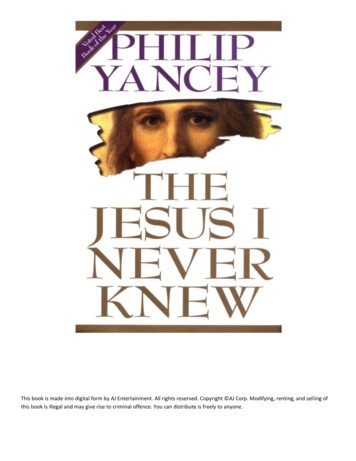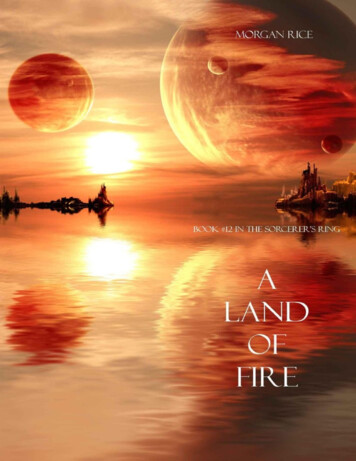
Transcription
This book is made into digital form by AJ Entertainment. All rights reserved. Copyright AJ Corp. Modifying, renting, and selling ofthis book is illegal and may give rise to criminal offence. You can distribute is freely to anyone.
CONTENTSPart OneWho He Was1. The Jesus I Thought I Knew2. Birth: The Visited Planet3. Background: Jewish Roots and Soil4. Temptation: Showdown in the Desert5. Profile: What Would I Have Noticed?Part TwoWhy He Came6. Beatitudes: Lucky Are the Unlucky7. Message: A Sermon of Offense8. Mission: A Revolution of Grace9. Miracles: Snapshots of the Supernatural10. Death: The Final Week11. Resurrection: A Morning beyond BeliefPart ThreeWhat He Left Behind12. Ascension: A Blank Blue Sky13. Kingdom: Wheat among the Weeds14. The Difference He Makes
PART ONE -WHO HE WASTHE JESUS I THOUGHT I KNEWSuppose we hear an unknown man spoken of by many men. Suppose we were puzzled to hear that some men said he was too talland some too short; some objected to his fatness, some lamented his leanness; some thought him too dark, and some too fair. Oneexplanation . . . would be that he might be an odd shape. But there is another explanation. He might be the right shape. . . . Perhaps(in short) this extraordinary thing is really the ordinary thing; at least the normal thing, the centre.G. K. ChestertonI first got acquainted with Jesus when I was a child, singing "Jesus Loves Me" in Sunday school, addressing bedtime prayers to "DearLord Jesus," watching Bible Club teachers move cutout figures across a flannel graph board. I associated Jesus with Kool-Aid andsugar cookies and gold stars for good attendance.I remember especially one image from Sunday school, an oil painting that hung on the concrete block wall. Jesus had long, flowinghair, unlike that of any man I knew. His face was thin and handsome, his skin waxen and milky white. He wore a robe of scarlet, andthe artist had taken pains to show the play of light on its folds. In his arms, Jesus cradled a small sleeping lamb. I imagined myself asthat lamb, blessed beyond all telling.Recently, I read a book that the elderly Charles Dickens had written to sum up the life of Jesus for his children. In it, the portraitemerges of a sweet Victorian nanny who pats the heads of boys and girls and offers such advice as, "Now, children, you must be niceto your mummy and daddy." With a start I recalled the Sunday school image of Jesus that I grew up with: someone kind andreassuring, with no sharp edges at all—a Mister Rogers before the age of children's television. As a child I felt comforted by such aperson.Later, while attending a Bible college, I encountered a different image. A painting popular in those days depicted Jesus, hands outstretched, suspended in a Dali-like pose over the United Nations building in New York City. Here was the cosmic Christ, the One inwhom all things in here, the still point of the turning world. This world figure had come a long way from the lamb-toting shepherd ofmy childhood.Still, students spoke of the cosmic Jesus with a shocking intimacy. The faculty urged us to develop a "personal relationship with Jesus"Christ, and in chapel services we hymned our love for him in most familiar terms. One song told about walking beside him in a garden with dew still on the roses. Students testifying about their faith casually dropped in phrases like "The Lord told me. . . ." My ownfaith hung in a kind of skeptical suspension during my time there. I was wary, confused, questioning.Looking in retrospect on my years at Bible College, I see that, despite all the devotional intimacies, Jesus grew remote from methere. He became an object of scrutiny. I memorized the list of thirty-four specific miracles in the Gospels but missed the impact ofjust one miracle. I learned the Beatitudes yet never faced the fact that none of us—I above all—could make sense of thosemysterious sayings, let alone live by them.A little later, the decade of the 1960s (which actually reached me, along with most of the church, in the early 1970s) calledeverything into question. Jesus freaks—the very term would have been an oxymoron in the tranquil 1950s—suddenly appeared onthe scene, as if deposited there by extraterrestrials. No longer were Jesus' followers well-scrubbed representatives of the middleclass; some were unkempt, disheveled radicals. Liberation theologians began enshrining Jesus on posters in a troika along with FidelCastro and Che Guevara.It dawned on me that virtually all portrayals of Jesus, including the Good Shepherd of my Sunday school and the United NationsJesus of my Bible College, showed him wearing a mustache and beard, both of which were strictly banned from the Bible College.Questions now loomed that had never occurred to me in childhood. For example, how would telling people to be nice to one
another get a man crucified? What government would execute Mister Rogers or Captain Kangaroo? Thomas Paine said that noreligion could be truly divine which has in it any doctrine that offends the sensibilities of a little child. Would the cross qualify?In 1971 I first saw the movie The Gospel according to St. Matthew, directed by Italian filmmaker Pier Paolo Pasolini. Its release hadscandalized not only the religious establishment, who barely recognized the Jesus on-screen, but also the film community, who knewPasolini as an outspoken homosexual and Marxist. Pasolini wryly dedicated the film to Pope John Paul XXIII, the man indirectlyresponsible for its creation. Trapped in an enormous traffic jam during a papal visit to Florence, Pasolini had checked into a hotelroom where, bored, he picked up a copy of the New Testament from the bedside table and read through Matthew. What hediscovered in those pages so startled him that he determined to make a film using no text but the actual words from Matthew'sgospel.Pasolini's film captures well the reappraisal of Jesus that took place in the 1960s. Shot in southern Italy on a tight budget, it evokes inchalky whites and dusty grays something of the Palestinian surroundings Jesus lived in. The Pharisees wear towering headpieces,and Herod's soldiers faintly resemble Fascist squadristi. The disciples act like bumbling raw recruits, but Jesus himself, with a steadygaze and a piercing intensity, seems fearless. The parables and other sayings, he fires in clipped phrases over his shoulder as hedashes from place to place.The impact of Pasolini's film can only be understood by one who passed through adolescence during that tumultuous period. Backthen it had the power to hush scoffing crowds at art theaters. Student radicals realized they were not the first to proclaim a messagethat was jarringly antimaterialistic, antihypocritical, pro-peace, and pro-love.For me, the film helped to force a disturbing revaluation of my image of Jesus. In physical appearance, Jesus favored those whowould have been kicked out of Bible college and rejected by most churches. Among his contemporaries he somehow gained areputation as "a wine-bibber and a glutton." Those in authority, whether religious or political, regarded him as a troublemaker, adisturber of the peace. He spoke and acted like a revolutionary, scorning fame, family, property, and other traditional measures of'success. I could not dodge the fact that the words in Pasolini's film were taken entirely from Matthew s gospel, yet their messageclearly did not fit my prior conception of Jesus.About this same time a Young Life worker named Bill Milliken, who had founded a commune in an inner-city neighborhood, wrote SoLong, Sweet Jesus. The title of that book gave words to the change at work inside me. In those days I was employed as the editor ofCampus Life magazine, an official publication of Youth For Christ. Who was this Christ, after all? I wondered. As I wrote, and editedthe writing of others, a tiny dybbuk of doubt hovered just to my side. Do you really believe that? Or are you merely dispensing the'party line, what you re paid to believe? Have you joined the safe, conservative establishment—modern versions of the groups whofelt so threatened by Jesus?As often as not I avoided writing directly about Jesus.When I switched on my computer this morning, Microsoft Windows flashed the date, implicitly acknowledging that, whatever youmay believe about it, the birth of Jesus was so important that it split history into two parts. Everything that has ever happened onthis planet falls into a category of before Christ or after Christ.Richard Nixon got carried away with excitement in 1969 when Apollo astronauts first landed on the moon. "It's the greatest daysince Creation!" crowed the president, until Billy Graham solemnly reminded him of Christmas and Easter. By any measure of historyGraham was right. This Galilean, who in his lifetime spoke to fewer people than would fill just one of the many stadia Graham hasfilled, changed the world more than any other person. He introduced a new force field into history, and now holds the allegiance ofa third of all people on earth.Today, people even use Jesus' name to curse by. How strange it would sound if, when a businessman missed a golf putt, he yelled,"Thomas Jefferson!" or if a plumber screamed "Mahatma Gandhi!" when his pipe wrench mashed a finger. We cannot get away fromthis man Jesus."More than 1900 years later," said H. G. Wells, "a historian like myself, who doesn't even call himself a Christian, finds the picturecentering irresistibly around the life and character of this most significant man. . . . The historian's test of an individual's greatness is
What did he leave to grow?' Did he start men to thinking along fresh lines with a vigor that persisted after him? By this test Jesusstands first." You can gauge the size of a ship that has passed out of sight by the huge wake it leaves behind.And yet I am not writing a book about Jesus because he is a great man who changed history. I am not tempted to write about JuliusCaesar or the Chinese emperor who built the Great Wall. I am drawn to Jesus, irresistibly, because he positioned himself as thedividing point of life—my life. "I tell you, whoever acknowledges me before men, the Son of Man will also acknowledge him beforethe angels of God," he said. According to Jesus, what I think about him and how I respond will determine my destiny for all eternity.Sometimes I accept Jesus' audacious claim without question. Sometimes, I confess, I wonder what difference it should make to mylife that a man lived two thousand years ago in a place called Galilee. Can I resolve this inner tension between doubter and lover?I tend to write as a means of confronting my own doubts. My book titles— Where Is God When It Hurts, Disappointment with God—betray me. I return again and again to the same questions, as if fingering an old wound that never quite heals. Does God care aboutthe misery down here? Do we really matter to God?Once, for a two-week period, I was snowbound in a mountain cabin in Colorado. Blizzards closed all roads and, somewhat likePasolini, I had nothing to do but read the Bible. I went through it slowly, page by page. In the Old Testament I found myselfidentifying with those who boldly stood up to God: Moses, Job, Jeremiah, Habakkuk, the psalmists. As I read, I felt I was watching aplay with human characters who acted out their lives of small triumph and large tragedy onstage, while periodically calling to an"''"unseen Stage Manager, You don t know what it s like out here! Job was most brazen, flinging to God this accusation: "Do you haveeyes of flesh? Do you see as a mortal sees?"Every so often I could hear the echo of a booming voice from far offstage, behind the curtain. "Yeah, and you don't know what it's"like back here either! it said, to Moses, to the prophets, most loudly to Job. When I got to the Gospels, however, the accusing voicesstilled. God, if I may use such language, "found out" what life is like in the confines of planet earth. Jesus got acquainted with grief inperson, in a brief; troubled life not far from the dusty plains where Job had travailed. Of the many reasons for Incarnation, surelyone was to answer Job's accusation: Do you have eyes of flesh? For a time, God did.If only I could hear the voice from the whirlwind and, like Job, hold a conversation with God himself. I sometimes think. And perhapsthat is why I now choose to write about Jesus. God is not mute: the Word spoke, not out of a whirlwind, but out of the human larynxof a Palestinian Jew. In Jesus, God lay down on the dissection table, as it were, stretched out in cruciform posture for the scrutiny ofall skeptics who have ever lived. Including me.The vision of Christ that thou dost see'Is my vision s greatest enemy:Thine has a great hook nose like thine,Mine has a snub nose like to mine.Both read the Bible day and night,'But thou read st black where I read white.-WILLIAM BLAKEAs I think about Jesus, an analogy from Karl Barth comes to mind. A man stands by a window gazing into the street. Outside, peopleare shading their eyes with their hands and looking up into the sky. Because of the overhang of the building though, the man cannotsee what it is they are pointing toward. We who live two thousand years after Jesus have a viewpoint not unlike the man standing bythe window. We hear the shouts of exclamation. We study the gestures and words in the Gospels and the many books they havespawned. Yet no amount of neck-craning will allow us a glimpse of Jesus in the flesh.The Jesus I Thought I Knew
For this reason, as William Blake's poem expresses so well, some-times those of us who look for Jesus cannot see past our own"noses. The Lakota tribe, for example, refers to Jesus as "the buffalo calf of God. The Cuban government distributes a painting ofJesus with a carbine slung over his shoulder. During the wars of religion with France, the English used to shout, "The pope is French"but Jesus Christ is English!Modern scholarship further muddies the picture. If you peruse the academic books available at a seminary bookstore you mayencounter Jesus as a political revolutionary, as a magician who married Mary Magdalene, as a Galilean charismatic, a rabbi, apeasant Jewish Cynic, a Pharisee, an anti-Pharisee Essene, an eschatological prophet, a "hippie in a world of Augustan yuppies," andas the hallucinogenic leader of a sacred mushroom cult. Serious scholars write these works, with little sign of embarrassment.*The U.S. public tends to ignore such trendy portrayals. A recent Gallup survey revealed that 84 percent of Americans believe Jesus Christ was God or the Son of God.Overwhelmingly Americans believe that Jesus was sinless, brave, and emotionally stable. By lesser margins they regard him as easy to understand (!), physicallystrong and attractive, practical, warm, and accepting.Athletes come up with creative portrayals of Jesus that elude modern scholarship. Norm Evans, former Miami Dolphins lineman,wrote in his book On God's Squad, "I guarantee you Christ would be the toughest guy who ever played this game. . . . If he were alivetoday I would picture a six-foot-six-inch 260-pound defensive tackle who would always make the big plays and would be hard tokeep out of the backfield for offensive linemen like myself." Fritz Peterson, former New York Yankee, more easily fancies Jesus in abaseball uniform: "I firmly believe that if Jesus Christ was sliding into second base, he would knock the second baseman into left fieldto break up the double play. Christ might not throw a spitball, but he would play hard within the rules."In the midst of such confusion, how do we answer the simple question, "Who was Jesus?" Secular history gives few clues. In adelicious irony, the figure who has changed history more than any other managed to escape the attention of most scholars andhistorians of his own time. Even the four men who wrote the Gospels omitted much that would interest modern readers, skipping'over nine-tenths of his life. Since none devotes a word to physical description, we know nothing about Jesus shape or stature or eyecolor. Details of his family life are so scant that scholars still debate whether or not he had brothers and sisters. The facts ofbiography considered essential to modern readers simply did not concern the gospel writers.Before beginning this book I spent several months in three seminary libraries—one Catholic, one liberal Protestant, one conservativeevangelical—reading about Jesus. It was daunting in the extreme to walk in the first day and see not just shelves but entire wallsdevoted to books about Jesus. A scholar at the University of Chicago estimates that more has been written about Jesus in the lasttwenty years than in the previous nineteen centuries. I felt almost as if the hyperbolic comment at the end of John's gospel hadcome true: "Jesus did many other things as well. If every one of them were written down, I suppose that even the whole worldwould not have room for the books that would be written."The agglomeration of scholarship began to have a numbing effect on me. I read scores of accounts of the etymology of Jesus' name,discussions of what languages he spoke, debates about how long he lived at Nazareth or Capernaum or Bethlehem. Any true-to-lifeimage receded into a fuzzy, indistinct blur. I had a hunch that Jesus himself would be appalled by many of the portrayals I wasreading.At the same time, with great consistency I found that whenever I returned to the Gospels themselves the fog seemed to lift. J. B.Phillips wrote, after translating and paraphrasing the Gospels, "I have read, in Greek and Latin, scores of myths, but I did not find theslightest flavour of myth here. No man could have set down such artless and vulnerable accounts as these unless some real Eventlay behind them."Some religious books have about them the sour smell of propaganda—but not the Gospels. Mark records what may be the mostimportant event in all history, an event that theologians strive to interpret with words like "propitiation, atonement, sacrifice," inone sentence: "With a loud cry, Jesus breathed his last." Odd, unpredictable scenes show up, such as Jesus' family and neighborstrying to put him away under suspicion of insanity. Why include such scenes if you are writing hagiography? Jesus' most devotedfollowers usually come off as scratching their heads in wonderment— Who is this guy?—more baffled than conspiratorial.Jesus himself, when challenged, did not offer airtight proofs of his identity. He dropped clues here and there, to be sure, but he also"said, after appealing to the evidence, "Blessed is he who takes no offense at me. Reading the accounts, it is hard to find anyone whodoes not at some point or another take offense. To a remarkable degree the Gospels throw the decision back to the reader. They
""operate more like a "whodunit (or as Alister McGrath has pointed out, a "whowashe ) detective story than like a connect-the-dotsdrawing. I found fresh energy in this quality of the Gospels.It occurs to me that all the contorted theories about Jesus that have been spontaneously generating since the day of his deathmerely confirm the awesome risk God took when he stretched himself out on the dissection table—a risk he seemed to welcome.Examine me. Test me. You decide.The Italian movie La Dolce Vita opens with a shot of a helicopter ferrying a giant statue of Jesus to Rome. Arms outstretched, Jesushangs in a sling, and as the helicopter passes over the landscape, people begin to recognize him. "Hey, it's Jesus!" shouts one oldfarmer, hop-ping off his tractor to race across the field. Nearer Rome, bikini-clad girls sunbathing around a swimming pool wave afriendly greeting, and the helicopter pilot swoops in for a closer look. Silent, with an almost doleful expression on his face, theconcrete Jesus hovers incongruously above the modern world.My search for Jesus took off in a new direction when the film-maker Mel White loaned me a collection of fifteen movies on the lifeof Jesus. They ranged from King of Kings, the 1927 silent classic by Cecil B. DeMille, to musicals such as Godspell and Cotton PatchGospel to the strikingly modern French-Canadian treatment Jesus of Montreal.I reviewed these films carefully, outlining them scene by scene. Then, for the next two years, I taught a class on the life of Jesus,using the movies as a springboard for our discussion.'The class worked like this. As we came to a major event in Jesus life, I would scout through the various films and from them selectseven or eight treatments that seemed notable. As class began, I would show the two- to four-minute clips from each film, beginningwith the comical and stiff renditions and working toward profound or evocative treatments. We found that the process of viewingthe same event through the eyes of seven or eight filmmakers helped to strip away the patina of predictability that had built up overyears of Sun-day school and Bible reading. Obviously, some of the film interpretations had to be wrong—they blatantly contradictedeach other—but which ones? What really happened? After reacting to the film clips we turned to the gospel accounts, and thediscussion took off.This class met at LaSalle Street Church, a lively congregation in downtown Chicago, which included Ph.D.'s from Northwestern aswell as homeless men who used the hour in a warm room as a chance to catch up on sleep. Thanks largely to the class, I graduallyunderwent a trans-formation in how I viewed Jesus. Walter Kasper has said, "Extreme notions . see God dressed as a FatherChristmas, or slipping into human nature like someone putting on dungarees in order to repair the world after a breakdown. Thebiblical and church doctrine that Jesus was a complete man with a human intellect and human freedom, does not seem to prevail inthe average Christian head." It did not prevail in my head, I admit, until I taught the class at LaSalle Street Church and sought toencounter the historical person Jesus.'Essentially, the films helped restore Jesus' humanity for me. The creeds repeated in churches tell about Christ s eternal preexistenceand glorious afterlife, but largely ignore his earthly career. The Gospels themselves were written years after Jesus' death, from thefar side of Easter, reporting on events as distant from the authors as the Korean War is from us today. The films helped me getfurther back, closer to a sense of Jesus' life as seen by his contemporaries. What would it have been like to hang on the edges of thecrowd? How would I have responded to this man? Would I have invited him over for dinner, like Zacchaeus? Turned away insadness, like the rich young ruler? Betrayed him, like Judas and Peter?Jesus, I found, bore little resemblance to the Mister Rogers figure I had met in Sunday school, and was remarkably unlike the per-sonI had studied in Bible college. For one thing, he was far less tame. In my prior image, I realized, Jesus' personality matched that of aStar Trek Vulcan: he remained calm, cool, and collected as he strode like a robot among excitable human beings on spaceship earth.That is not what I found portrayed in the Gospels and in the better films. Other people affected Jesus deeply: obstinacy frustratedhim, self-righteousness infuriated him, simple faith thrilled him. Indeed, he seemed more emotional and spontaneous than theaverage person, not less. More passionate, not less.The more I studied Jesus, the more difficult it became to pigeon-hole him. He said little about the Roman occupation, the main topicof conversation among his countrymen, and yet he took up a whip to drive petty profiteers from the Jewish temple. He urgedobedience to the Mosaic law while acquiring the reputation as a lawbreaker. He could be stabbed by sympathy for a stranger, yet
"turn on his best friend with the flinty rebuke, Get behind me, Satan!" He had uncompromising views on rich men and loose women,yet both types enjoyed his company.One day miracles seemed to flow out of Jesus; the next day his power was blocked by people's lack of faith. One day he talked indetail of the Second Coming; another, he knew neither the day nor hour. He fled from arrest at one point and marched inexorablytoward it at another. He spoke eloquently about peacemaking, then told his disciples to procure swords. His extravagant claimsabout himself kept him at the center of controversy, but when he did something truly miraculous he tended to hush it up. As WalterWink has said, if Jesus had never lived, we would not have been able to invent him.Two words one could never think of applying to the Jesus of the Gospels: boring and predictable. How is it, then, that the church hastamed such a character—has, in Dorothy Sayers' words, "very efficiently pared the claws of the Lion of Judah, certified Him as ah"fitting ousehold pet for pale curates and pious old ladies ?"Pulitzer prize-winning historian Barbara Tuchman insists on one rule in writing history: no "flash-forwards. When she was writingabout the Battle of the Bulge in World War II, for example, she resisted the temptation to include "Of course we all know how this"turned out asides. In point of fact, the Allied troops involved in the Battle of the Bulge did not know how the battle would turn out.From the look of things, they could well be driven right back to the beaches of Normandy where they had come from. A historianwho wants to retain any semblance of tension and drama in events as they unfold dare not flash-forward to another, all-seeing pointof view. Do so, and all tension melts away. Rather, a good historian re-creates for the reader the conditions of the history being"described, conveying a sense that "you were there.That, I concluded, is the problem with most of our writing and thinking about Jesus. We read the Gospels through the flash-forwardlenses of church councils like Nicea and Chalcedon, through the church's studied attempts to make sense of him.Jesus was a human being, a Jew in Galilee with a name and a family, a person who was in a way just like everyone else. Yet inanother way he was something different than anyone who had ever lived on earth before. It took the church five centuries of activedebate to agree on some sort of epistemological balance between "just like everyone else" and "something different." For those of"us raised in the church, or even raised in a nominally Christian culture, the balance inevitably tilts toward "something different. AsPascal said, "The Church has had as much difficulty in showing that Jesus Christ was man, against those who denied it, as in showingthat he was God; and the probabilities were equally great."Let me make it clear that I affirm the creeds. But in this book I hope to go back beyond those formulations. I hope, as far as ispossible, to look at Jesus' life "from below," as a spectator, one of the many who followed him around. If I were a Japanesefilmmaker, given 50 million and no script but the Gospels' text, what kind of film would I make? I hope, in Luther's words, to "draw"Christ as deep as possible into the flesh.In the process, sometimes I have felt like a tourist walking around a great monument, awed and overwhelmed. I circle themonument of Jesus inspecting its constituent parts—the birth stories, the teachings, the miracles, the enemies and followers—inorder to reflect on and try to comprehend the man who has changed history.Other times I have felt like an art restorer stretched out on the scaffolding of the Sistine Chapel, swabbing away the grime of historywith a moistened Q-tip. If I scrub hard enough, will I find the original beneath all those layers?In this book I attempt to tell the story of Jesus, not my own story. Inevitably, though, a search for Jesus turns out to be one's ownsearch. No one who meets Jesus ever stays the same. I have found that the doubts that afflict me from many sources—from science,from comparative religion, from an innate defect of skepticism, from aversion to the church—take on a new light when I bring thosedoubts to the man named Jesus. To say more at this stage, in this first chapter, would cause me to break Barbara Tuchman'scherished principle.
2. BIRTH: THE VISITED PLANETThe God of power, as he did rideIn his majestic robes of gloryResolved to light; and so one dayHe did descend, undressing all the way.George HerbertSorting through the stack of cards that arrived at our house last Christmas, I note that all kindsof symbols have edged their way into the celebration. Overwhelmingly, the landscape scenesrender New England towns buried in snow, usually with the added touch of a horse-drawnsleigh. On other cards, animals frolic: not only reindeer, but also chipmunks, raccoons,cardinals, and cute gray mice. One card shows an African lion reclining with a foreleg drapedaffectionately around a lamb.Angels have made a huge comeback in recent years, and Hall-mark and American Greetingsnow feature them prominently, though as demure, cuddly-looking creatures, not the type whowould ever need to announce "Fear not!" The explicitly religious cards (a distinct minority)focus on the holy family, and you can tell at a glance these folks are different. They seemunruffled and serene. Bright gold halos, like crowns from another world, hover just above theirheads.Inside, the cards stress sunny words like love, goodwill, cheer, happiness, and warmth. It is afine thing, I suppose, that we honor a sacred holiday with such homey sentiments. And yetwhen I turn to the gospel accounts of the first Christmas, I hear a very different tone and sensemainly disruption at work.I recall watching an episode of the TV show Thirty something in which Hope, a Christian,argues with her Jewish husband, Michael, about the holidays. "Why do you even bother withHanukkah?" she asks. "Do you really believe a handful of Jews held off a huge army by using abunch of lamps that miraculously wouldn't run out of oil?"Michael
I am drawn to Jesus, irresistibly, because he positioned himself as the dividing point of life—my life. "I tell you, whoever acknowledges me before men, the Son of Man will also acknowledge him before the angels of God," he said. According to Jesus, what I think about him and how I respond will determine my destiny for all eternity.File Size: 1MB











